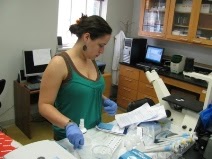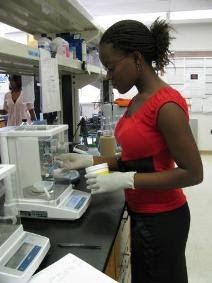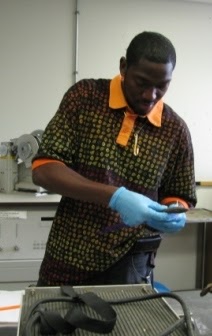2009 Student Participants

Erika Busch (University of Redlands)
Mentors: Dr. Yan Waguespack, Andriy Tkachenko
Research Interests: Environmental Chemistry
Research Project: Characterization of mucin-glycoproteins in skin mucus of fish
A biochemical method for separating and comparing different mucous constituents in Atlantic Salmon and Hybrid Tilapia is reported. This was achieved by performing several different tests including Isopycnic Density Gradient Centrifugation, Coomassie Blue Assay, Periodic Acid Schiff Assay, Iodine Assay, Absorbance at 280nm, and Size-Exclusion Chromatography. The mucous constituents were separated, and it was confirmed that, for Atlantic Salmon, mucin-glycoproteins were found in higher concentration at lower densities that those in Hybrid Tilapia. This result is consistent with result of previous studies on the subject.

Elizabeth Diaz-Stubbs (Montgomery College)
Mentors: Dr. Ali Ishaque, Nadia Abou-Zeid
Research Interests: Ecotoxicology
Research Project: The effects of benzo[a] pyrene and PCB77 on the expression of the fish ovarian enzyme, cyp19a
Atlantic tomcod populations from the Hudson River Bay have been exposed to high concentrations of the toxic Polychlorinated Biphenyls (PBCs) and Polycyclic Aromatic Hydrocarbons (PAHs). The present study sought to identify the expression of the aromatase enzyme cyp19a on the Atlantic tomcod (Microgradus tomcod). Tomcod embryos from the Hudson River (New York, USA) and the Shinecock Bay (New Jersey. USA) were injected with two environmentally relevant dosage levels of PCB77 and PAHs. The RNA from ovarian tissue samples was analyzed using Real Time Reverse Transcriptase PCR (RT PCR). Previously, it was discovered that mechanistic pathways of PAH benzo[a]pyrene and PCB-77 contaminants do not have an additive effect on the expression of the cyp19a ovarian aromatase gene in Atlantic tomcod. We found a fragment that we can sequence, clone and design proper primers for the qRT-PCR. Obviously, this experiment needs further analysis. Hopefully, this will serve as reference for other toxicological studies of marine and estuarine species.

Cecelia Gallenstein (Transylvania University)
Mentors: Dr. Doug Ruby, Morgan Kaumeyer
Research Interests: Herpetology
Research Project: Microhabitat preferences of tree frogs on the Maryland Coastal Plain

Keya Jackson (Hampton University)
Mentors: Dr. Madhumi Mitra, Matilda Madden
Research Interests: Marine Botany
Research Project: Seasonal variation in total dietary fiber content of Delmarva seaweed
Seaweed is a cash crop industry used as a source of food all over the world in Asian regions and countries such as Japan, Ireland, and Scotland. Within the Delmarva Peninsula of the United States there is an abundance of seaweed that has not yet been used as a source of food or substance used to better human health. In this study, a nutritional analysis of total dietary fiber (TDF) in three edible seaweeds, Fucus vesiculosus (Phaeophyta),Gracilaria tikvahiae(Rhodophyta), and Ulva lactuca (Chlorophyta) collected from Chincoteague Memorial Park, Chincoteague, VA, and Indian River Inlet, DE, was conducted to establish seasonality of total dietary fiber, and investigate site variations. Samples of seaweeds were collected in summer, fall and winter of 2006 and spring of 2007, and analyzed for total dietary fiber. Water quality data such as temperature, salinity, and pH were measured on each sample date with a multiparameter YSI unit. Water temperature varied from 20.4°C (DE) to a maximum of 29.5 °C (VA) in summer 2006 and 1.1 °C (DE) to a maximum of 3.2 °C (DE). Salinity varied from 18.7-30.38 ppt (DE) and 23.8-28.3 ppt (VA) and the pH remained constant between 7-8 at both sites. Fucus was a common species between the two sample sites, and varied in total dietary fiber from 40.12-65.3% (DE) and 45.6%-76.8% (VA). Gracilaria, available at the Virginia site only ranged from 47.2-55.3%, and Ulva ranged from 42.6- 51.0% (DE) but there was not enough to be analyzed seasonally from the Virginia site. T-tests for paired samples (α=0.05) were conducted to investigate perceived seasonal differences in the fiber data. There were no significant seasonal changes in the total dietary fiber for VirginiaGracilaria, however there was a significant decrease in fiber content in Delaware Fucus between summer and fall 2006 and a significant increase in fiber content in Virginia Fucus between winter 2006 and spring 2007. Additionally, the fiber content of Virginia Fucus was significantly higher than that of its Delaware counterpart in and winter 2006 and spring 2007. As plant age is correlated to total fiber content it is possible that the ages of the samples collected in Virginia were older than that of Delaware.

Wundu Kwembe (Jackson State University)
Mentors: Dr. Salina Parveen, Meshak Mudoh
Research Interests: Environmental Microbiology
Research Project: Growth & survival of pathogenic Vibrio parahaemolyticus in American oysters
Vibrio parahaemolyticus (Vp) is a naturally occurring halophilic bacterium that can cause gastroenteritis in seafood consumers. Information is limited on pathogenic Vp growth and survival in seafood, especially in post-harvest shell stock oysters under various storage conditions. The objective of this study was to address this data gap. Oysters harvested from Gulf Coast (Spring 2007) were stored at 5, 10, 15, 20, 25, and 30ºC for selected time intervals. At each time interval, oysters were analyzed for pathogenic (tdh- and trh-positive) Vp by MPN-qPCR. Maximum growth rates (GRs) were estimated at each storage temperature by a generalized linear mixed model Assuming a linear model for the initial growth phase, the best estimates of GR of tdh and trh- positive Vp at 5, 10, 15, 25,, and 30°C were 0.006, <0.001, 0.16 0.27, 0.15, and 0.024, 0.006, 0.25, 0.21 and 0.16log/h , respectively. When total and patogenic Vp GRs were compared, the GR of total, tdh- and trh- positve Vp were Similar at 30°C. However the GR of pathgenic Vp were substantially greater at lower temperatures than those observed for total Vp. Analysis of similar data sets from the summer and fall of 2007 is under way to comfirm these findings, which may be of value for refining existing risk assessment models and developing Vp control plans.

Olivia Martin (University of Maryland Eastern Shore)
Mentor: Dr. Eric May
Research Interests: Fish Ecology
Research Project: Skin ulcers and fin rot disease in summer flounder from the Maryland Coastal Bays
The Maryland Coastal Bays represent a complex set of estuarine bays and rivers on the Delmarva Peninsula that serve as important habitats for a variety of resident and transient species. Because of the importance of the bays as nursery and feeding habitats, considerable concern is given to the over-development and pollution of its many bays and tributaries. Concern is also expressed regarding the potential for the waters to have adverse effects on human health. In surveying coastal systems for the biological effects of pollutants much attention has been paid to using specific fish species as indicators. Responses in fish such as ulcers, sores, fin rot, and gill fraying have been used in other areas as indicators of deteriorated environments. In the Maryland Coastal Bays one of the most ubiquitous species is the summer flounder (Paralicthys dentatus) which is a demersal fish spending most of its early life living on the bottom. Given the close contact with sediments it is felt that this would be a good candidate species as an indicator of environmental degradation. We sampled summer flounder at nine sites in the Maryland Coastal bays in Chincoteague, Newport, Sinepuxent, Isle of Wight and Assawoman Bays as well as the St. Martins River. During this time we collected 19 summer flounder, of which only one exhibited any lesions. This fish was from the St. Martins River and exhibited multiple fine blood spots known as petechiae.

Doris Takwe (University of Maryland Eastern Shore)
Mentors: Dr. Joseph Pitula, Habibul Bakht
Research Interests: Marine Genetics
Research Project: Effect of probiotic diet on gut microflora of Atlantic croaker
Fish gut microflora play key roles in overall fish health. Studies showed that manipulating the gut flora towards a potentially more beneficial microbial community may improve fish health. In a previous study conducted at the UMES aquaculture facility, the investigators used probiotic bacteria as feed supplement to improve Rainbow Trout gut flora. As a continuation of that study, we examined Rainbow Trout fish gut samples to detect bacterial population by PCR analysis. We extracted DNA from the guts following Phenol-Chloroform method. DNA isolated from the fish guts were then subjected to PCR targeting V5 region of the bacterial 16SrDNA using the universal primers 357F-907R. Results showed amplification of the target gene in some samples.

Matthew Taylor (Hampton University)
Mentor: Dr. Paulinus Chigbu
Research Interests: Community Ecology
Research Project: Abundance and Distribution of Ichthyoplankton and Ctenophores in Maryland Coastal Bays
Information is available on spatiotemporal patterns of ichthyoplankton ingress through inlets into the Maryland Coastal Bays (MCBs). However, there are no previous studies on the composition, abundance and distribution of larval fishes in the Lagoons or on the distribution of ctenophores which are major predators of fish larvae and eggs. Ichthyoplankton and ctenophore samples were collected from 9 sites in MCBs in June and July using a Bongo Net (333 micron). Larval fish samples were preserved in 10% formalin and subsequently sorted, identified and counted in the lab. Ctenophore (Mnemiopsis sp.) biovolumes were determined in the field. Physical and chemical characteristics of water were measured using a YSI 85 meter. Four different types of larval fish were identified, the most abundant of which was Bay Anchovies, Anchoa mitchelli (96.5%). Larval fish, eggs, and crustacean larvae densities varied among stations with the highest densities, 7m-3, 41m-3, 26m-3, respectively at station 7 in Chincoteaque Bay. Ctenophore biovolume decreased from station 4 (~10ml m-3) in the northern MCB to station 16 (~1ml m-3) in Chincoteague Bay. No strong correlation was found between fish larvae and ctenophore biovolume. Studies are continuing to document seasonal changes in larval fish and ctenophore densities and distributions in MCBs and to evaluate the potential impacts of ctenophores on larval fish mortality.

Genevieve Warmann (University of Maryland Eastern Shore)
Mentors: Dr. Paulinus Chigbu, Tedra Booker
Research Interests: Aquaculture
Research Project: The effect of Garcinia sp. seed extract on the hematological parameters of rainbow trout
The objective of this preliminary study was to investigate the effects of Garcinia kola on the hematological parameters of Rainbow trout (Onchorynchus mykiss). Three control and three experimental groups, selected randomly were maintained in recirculating fish tanks. The control groups were fed commercially available fish feed while the experimental groups were fed with the commercial fish feed mixed with ethanol extract of Garcinia kola. The fish were measured and weighed weekly over a period of five weeks and at the end of the experiment their hematological parameters were studied to observe changes. No differences were observed in the growth rates of treated and control fish. Red Blood Cell and White Blood Cell counts were higher in fish feed Garcinia extracts than in control fish suggesting that the plant extracts may have an immunomodulatory effects on fish.


